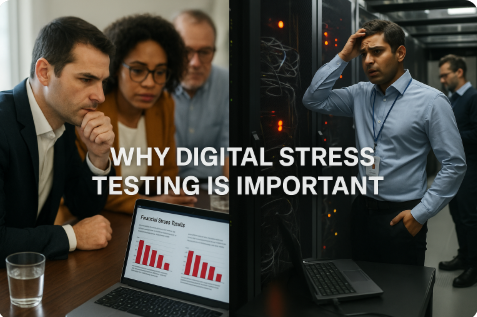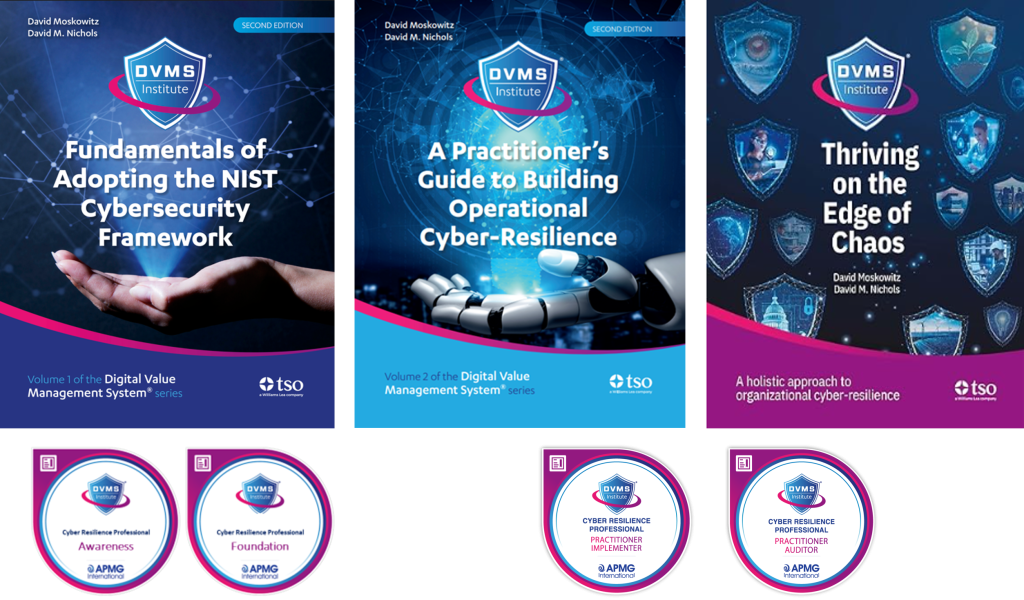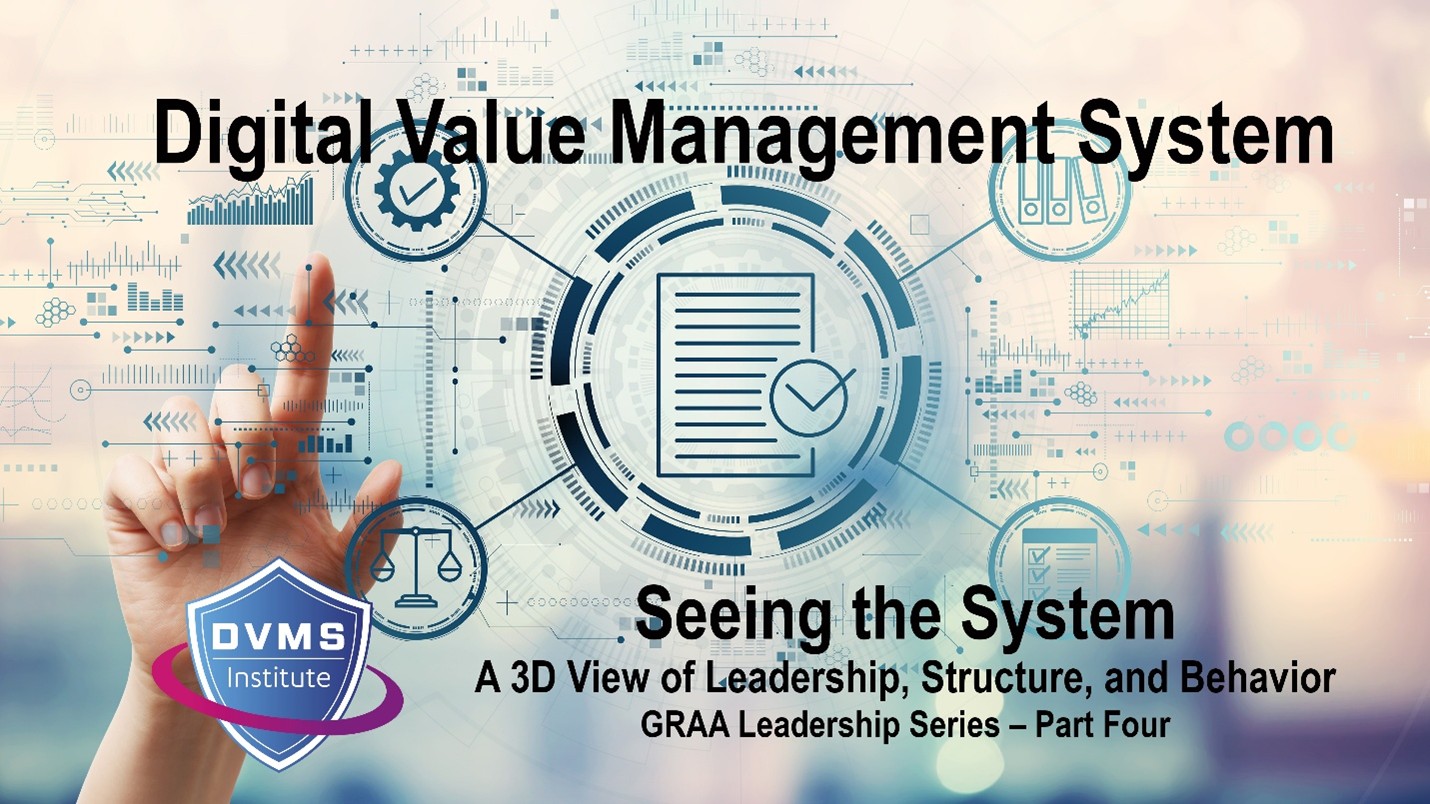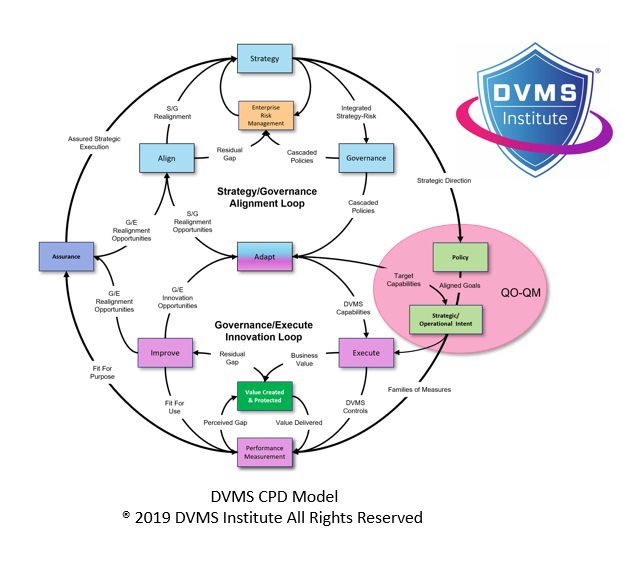The Case for Digital Stress Testing – Ensuring Resilience Beyond Compliance
Rick Lemieux – Co-Founder and Chief Product Officer of the DVMS Institute
The New Reality of Digital Dependence
In today’s hyper-connected economy, organizations depend on digital infrastructure just as nations rely on their financial systems. Data platforms, supply chains, and AI-driven operations form the arteries of modern business. Yet, while central banks routinely stress test financial institutions to ensure systemic stability, few organizations apply the same rigor to their digital ecosystems.
The outcome is predictable: organizations may look compliant on paper, yet crumble under digital pressure. As outlined in the DVMS Institute’s white paper, “The Assurance Mandate,” it’s time to recognize digital resilience as a strategic imperative—not a technical afterthought.
From Financial Stress Tests to Digital Assurance
Banking regulators have learned long ago that static compliance is insufficient. Following the 2008 financial crisis, regulators introduced stress testing to expose vulnerabilities that traditional audits had missed. These tests simulate market shocks, liquidity shortages, and operational crises to ensure banks can absorb disruption and continue serving the economy.
Digital systems require the same logic. Cyberattacks, supply chain breakdowns, and AI failures can now trigger systemic risks equal to financial contagion. A digital stress test is the organizational equivalent: a structured, evidence-based exercise that measures whether critical services can continue to create, protect, and deliver value when systems fail. Just as regulators no longer accept financial stability on trust, boards should not accept digital stability based solely on certifications.
Why Compliance Isn’t Confidence
Traditional governance frameworks and standards—such as NIST, GRC, ISO, and ITSM—are essential maps, but they are not the journey itself. They ensure organizations look orderly but don’t prove they can perform under stress. SolarWinds, Snowflake, and Colonial Pipeline all maintained impressive certifications before their crises. These artifacts offered reassurance, not resilience. Compliance measures alignment, not adaptability. It tells us whether policies exist, not whether people and systems will act effectively when chaos hits. In the same way that a bank’s capital ratios mean little without real-world liquidity tests, a cybersecurity audit means little without proof that controls hold when adversaries adapt. Stress testing bridges this gap between documentation and demonstrated capability.
The Digital Value Management System Advantage
The Digital Value Management System (DVMS) provides the operating system for institutionalizing these stress tests. As The Assurance Mandate explains, a DVMS evolves fragmented, control-driven programs (NIST, ITSM, GRC, ISO) into a unified, adaptive governance, resilience, and assurance system.
Rather than replacing existing frameworks, it overlays them—connecting governance intent, operational processes, and assurance evidence in one continuous loop. Through its Create–Protect–Deliver (CPD) model, a DVMS assesses whether digital value creation remains viable in the face of stress. It asks: Can we still create value? Can we still protect it? Can we still deliver it? The system translates these questions into measurable outcomes and real-time evidence.
This approach mirrors the financial sector’s use of scenario-based testing, where performance under adverse conditions determines confidence in stability.
The Illusion of Safety in Fragmented Systems
Just as interbank risk once went unseen until a crisis exposed it, digital fragility often remains hidden within organizational silos. IT, cybersecurity, and compliance frequently operate independently, each claiming success through isolated metrics. But resilience is systemic. If one domain fails to communicate, the whole enterprise falters. Stress testing forces convergence, as it reveals dependencies among governance, operations, and culture. For example, a DVMS-driven stress test might simulate a cloud outage or ransomware attack, tracing not only technical responses but also decision-making, communication, and recovery time. When done regularly, these exercises generate assurance evidence—proof that the organization’s integrated systems can withstand and adapt to changes.
Culture: The Invisible Variable
Peter Drucker’s adage that “culture eats strategy for breakfast” applies equally to controls. Boeing, Equifax, and Colonial Pipeline demonstrate how compliance can collapse when culture discourages escalation or transparency. Stress testing exposes these weaknesses.
A digital stress test measures not only whether controls exist, but whether people act on them. Do teams escalate incidents quickly? Do executives prioritize continuity over optics? Within a DVMS, culture becomes visible through evidence—how fast decisions are made, how cross-functional collaboration occurs, and whether lessons lead to continuous improvement. In this sense, digital stress testing is as much a test of leadership integrity as of technical robustness.
From Governance, Risk, and Compliance (GRC) to Governance, Resilience, and Assurance (GRA)
The Assurance Mandate frames this transition as the evolution from GRC to GRA—from retrospective documentation to forward-looking assurance. GRC informs boards about the controls that existed yesterday; GRA demonstrates how those controls will perform tomorrow. A stress-tested organization doesn’t just produce reports—it demonstrates capability under stress. This shift mirrors how regulators moved from paper-based oversight to live solvency tests. In both cases, the goal is to replace “trust us” with “test us.” The DVMS operationalizes GRA by providing boards with live, evidence-driven insights into resilience performance, rather than static maturity charts.
Technology as the Enabler
For decades, continuous assurance seemed too burdensome. Collecting and analyzing data across systems was slow and costly—the “burden of assurance”. AI and automation have changed that. Agentic systems now enable continuous monitoring, predictive analytics, and real-time feedback loops. A DVMS equipped with AI can track resilience indicators—such as recovery times, escalation speed, and vendor dependencies—just as financial regulators monitor capital adequacy ratios. Automated dashboards synthesize IT, cyber, and governance data into a single, board-level assurance view. The same tools that once fueled digital complexity can now make digital assurance practical.
Stress Testing as a Strategic Advantage
Organizations that treat stress testing as a regulatory chore miss its strategic potential. Financial institutions use stress test outcomes to refine their strategies, adjust portfolios, and strengthen their trust with investors. Similarly, digital stress testing can inform decisions regarding innovation and investment. When a DVMS reveals a resilience gap, it identifies an opportunity: redesign workflows, modernize vendor contracts, or automate recovery processes. Boards can then reframe assurance from defensive reporting to proactive improvement. Assurance becomes the engine of innovation—the feedback system that continuously raises organizational capability.
The Trust Dividend
In finance, stress testing rebuilt public trust after the crisis. In the digital economy, it can do the same. Stakeholders—customers, regulators, investors—are increasingly skeptical of compliance badges. They want evidence of continuity and integrity. By institutionalizing digital stress testing through a DVMS, organizations demonstrate transparency, accountability, and competence.
Trust, not technology, becomes the differentiator. Firms that can demonstrate resilience attract more investment, secure better partnerships, and maintain customer loyalty during crises. In an era where disruptions are inevitable, the ability to demonstrate assurance is the new measure of value.
Conclusion: From Reassurance to Confidence
Government regulators stress test banks because the collapse of one institution can endanger an entire economy. The same principle now applies to digital enterprises: a single systemic failure can ripple across supply chains, markets, and nations.
As The Assurance Mandate concludes, compliance brought us here; assurance will take us further. Stress testing digital systems is not about adding bureaucracy; it is about demonstrating maturity. Through the DVMS, organizations can evolve from managing frameworks to managing resilience—from reassuring stakeholders to giving them genuine confidence.
In short: resilience must be proven, not presumed. Just as the financial world learned that trust requires evidence, the digital world must now know the same lesson—before the subsequent systemic failure teaches it for us.
About the Author

Rick Lemieux
Co-Founder and Chief Product Officer of the DVMS Institute
Rick has 40+ years of passion and experience creating solutions to give organizations a competitive edge in their service markets. In 2015, Rick was identified as one of the top five IT Entrepreneurs in the State of Rhode Island by the TECH 10 awards for developing innovative training and mentoring solutions for boards, senior executives, and operational stakeholders.
Digital Value Management System® (DVMS)
The DVMS is an adaptive, culture-enabled overlay system designed to help organizations of any size transition from static, paper-based governance systems to a living, evidence-based system of Governance, Resilience, Assurance, and Accountability (GRAA).
At its core, the DVMS is a simple but powerful integration of:
-
Governance Intent – shared expectations and accountabilities.
-
Operational Capability – how the business actually performs
-
Assurance Evidence – proof that intended outcomes are being achieved
Rather than adding more complexity, a DVMS integrates Fragmented Governance Frameworks and Practices such as NIST CSF, GRC, ITSM, DevOps, and AI into a unified overlay system that enables leaders and regulators to see, in real time, whether the digital business is working as intended—and whether the risks that matter most are being managed proactively.
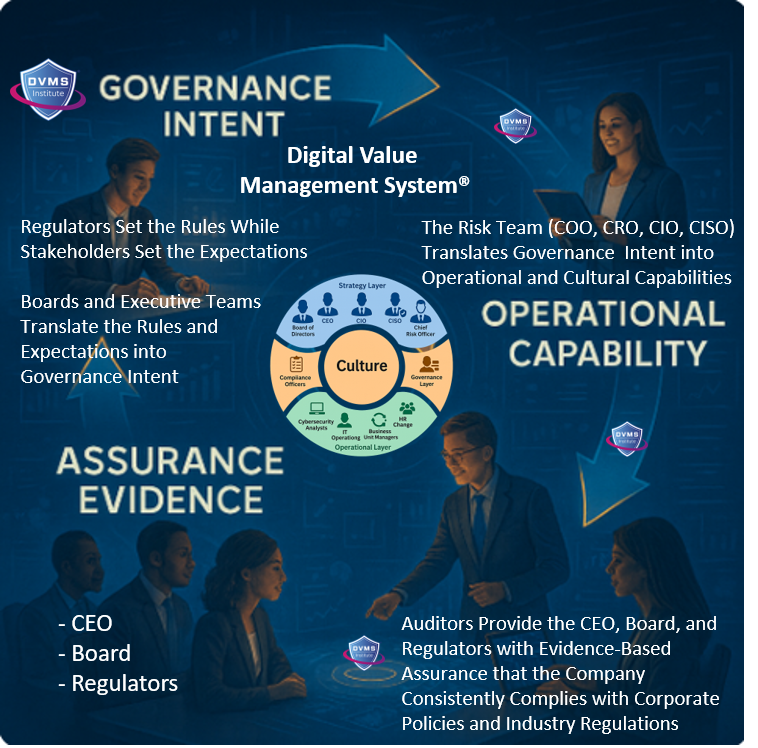
Through its MVC, CPD, 3D Knowledge, and FastTrack Models, a DVMS turns this integration into three distinctive capabilities:
A Governance Overlay that replaces fragmentation with unity. The DVMS provides organizations with a structured way to connect strategy with day-to-day execution. Leaders gain a consistent mechanism to direct, measure, and validate performance—across every system responsible for digital value.
A Behavioral Engine that drives high-trust, high-velocity decision-making. The DVMS embeds decision models and behavioral patterns that help teams think clearly and act confidently, even in uncertain situations. It is engineered to reduce friction, prevent blame-based cultures, and strengthen organizational reliability.
A Learning System that makes culture measurable, adaptable, and scalable. Culture becomes a managed asset—not an abstract concept. The DVMS provides a repeatable way to observe behavior, collect evidence, learn from outcomes, and evolve faster than threats, disruptions, or market shifts.
DVMS Organizational Benefits
Instead of replacing existing operational frameworks, the DVMS elevates them—connecting and contextualizing their data into actionable intelligence that validates performance and exposes the reasons behind unmet outcomes.
By adopting a DVMS, organizations are positioned to:
- Maintain Operational Stability Amidst Constant Digital Disruption
- Deliver Digital Value and Trust Across A Digital Ecosystem
- Satisfy Critical Regulatory and Certification Requirements
- Leverage Cyber Resilience as a Competitive Advantage
DVMS Leadership Benefits
The Digital Value Management System (DVMS) provides leaders with a unified, evidence-based approach to governing and enhancing their digital enterprise, aligning with regulatory requirements and stakeholder expectations.
For the CEO, the DVMS provides a clear line of sight between digital operations, business performance, and strategic outcomes—turning governance and resilience into enablers of growth and innovation rather than cost centers.
For the Board of Directors, the DVMS provides ongoing assurance that the organization’s digital assets, operations, and ecosystem are governed, protected, and resilient—supported by evidence-based reporting that directly links operational integrity to enterprise value and stakeholder trust.
For the CIO, CRO, CISO, and Auditors: an integrated, adaptive, and culture-driven governance and assurance management system that enhances digital business performance, resilience, trust, and accountability
DVMS White Papers
The three whitepapers below present a coherent progression that shifts organizations from compliance-driven thinking to a modern system of Governance, Resilience, Assurance, and Accountability (GRAA). Collectively, the three papers define a comprehensive system for building and governing resilient digital enterprises, grounded in evidence rather than assumptions.
The Assurance Mandate Paper sets the stage by showing why traditional GRC artifacts provide only reassurance—not evidence—and calls boards to demand forward-looking proof that their organizations can continue to create, protect, and deliver value under stress.
The Assurance in Action Paper elevates the conversation from leadership intent to managerial execution, demonstrating how the DVMS operationalizes resilience by translating outcomes into Minimum Viable Capabilities, connecting frameworks through the Create–Protect–Deliver model, and generating measurable assurance evidence that managers can use to demonstrate real performance rather than activity.
The Governing by Assurance Paper elevates the approach to the policy and regulatory level, showing how DVMS functions as a learning overlay system that links governance intent, operational capability, and verifiable evidence into a continuous loop—enabling regulators, agencies, and enterprises to govern by outcomes rather than checklists and to prove capability with measurable, auditable performance data.
DVMS Cyber Resilience Certified Training Programs
DVMS Cyber Resilience Awareness Training
The DVMS Cyber Resilience Awareness course and its accompanying body of knowledge publication educate all employees on the fundamentals of digital business, its associated risks, the NIST Cybersecurity Framework, and their role within a shared model of governance, resilience, assurance, and accountability for creating, protecting, and delivering digital value.
This investment fosters a culture that is prepared to operate within a system capable of transforming systemic cyber risks into operational resilience.
DVMS NISTCSF Foundation Certification Training
The DVMS NISTCSF Foundation certification training course and its accompanying body of knowledge publications provide ITSM, GRC, Cybersecurity, and Business professionals with a detailed understanding of the NIST Cybersecurity Framework and its role in a shared model of governance, resilience, assurance, and accountability for creating, protecting, and delivering digital value.
This investment fosters IT, GRC, Cybersecurity, and Business professionals with the skills to operate within a system capable of transforming systemic cyber risks into operational resilience.
DVMS Cyber Resilience Practitioner Certification Training
The DVMS Practitioner certification training course and its accompanying body of knowledge publications teach ITSM, GRC, Cybersecurity, and Business practitioners how to elevate investments in ITSM, GRC, Cybersecurity, and AI business systems by integrating them into a unified governance, resilience, assurance, and accountability system designed to proactively identify and mitigate the cyber risks that could disrupt operations, erode resilience, or diminish client trust.
This investment fosters IT, GRC, Cybersecurity, and Business practitioners with the skills to assess, design, implement, operationalize, and continually innovate a Digital Value Management System® program that operationalizes a shared model of governance, resilience, assurance, and accountability for creating, protecting, and delivering digital value.
Company Brochures and Presentation
Explainer Videos
- DVMS Architecture Video: David Moskowitz explains the DVMS System
- DVMS Case Study Video: Dr. Joseph Baugh Shares His DVMS Story.
- DVMS Overlay Model – What is an Overlay Model
- DVMS MVC ZX Model – Powers the CPD
- DVMS CPD Model – Powers DVMS Operations
- DVMS 3D Knowledge Model – Powers the DVMS Culture
- DVMS FastTrack Model – Enables A Phased DVMS Adoption
Digital Value Management System® is a registered trademark of the DVMS Institute LLC.
® DVMS Institute 2025 All Rights Reserved

